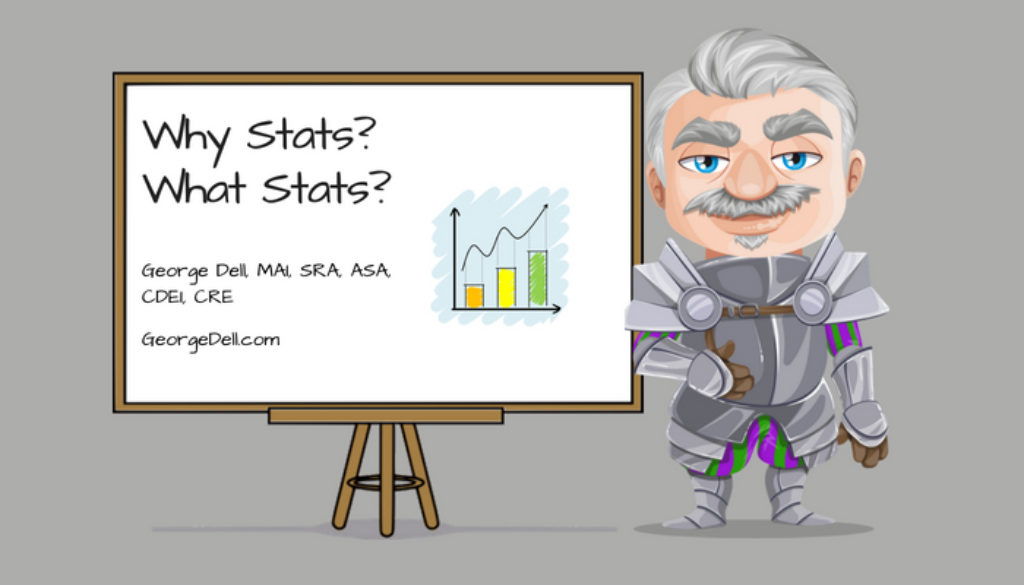Stats can be troublesome. Knowing the why, the what, and the how of statistics can help rescue the appraisal profession. Continued misuse and misunderstanding will help bury it. Let’s look at these three questions. We look at misused words, statistics, and the opportunity.
First: “The main problem with statistics is words.”
Statistics is the study of data.
Statistics are random sample approximations of population parameters.
Inference is “a conclusion based on evidence and reasoning.” (Logical inference).
Inference is “a sampling approximation of population parameters.” (Statistical inference)
Bias can be personal or analytical
Objective can be personal, analytical, or the goal.
Each of these words are important to appraisal analysis and reporting. They are often used sloppily. This is a “why” to the confusion of statistics in appraisal.
Let’s next look at the “what” of statistics. There are four primary types of statistics:
- Descriptive statistics: summary parameters of any data set (mean, median, standard deviation, skew, kurtosis, and percentiles).
- Inferential statistics: parameters of a random sample, to approximate population parameters.
- Bayesian statistics: current data combined with prior knowledge or belief to interpret probability.
- Non-parametric: non-normal or ordinal data analyzed from ranking rather than parameters
Of the four types, descriptive, Bayesian and nonparametric are very useful for valuation. Inferential statistics are not very useful. (“We don’t do no random samples”.) For appraisal, the exact opposite is required: We pick our comps very carefully. The main problem is that our “advanced” body of knowledge emphasizes inferential statistics. Appraisal education devotes insufficient time to proper modeling and communication (including graphs), but a lot of time on p-values, t-scores and confidence intervals, which do not apply to judgement/convenience selection of comps. (All based on subjectively selected data.)
The how of statistics, can help return the profession to the technical aspects of methodologies, as was emphasized in earlier editions of the Appraisal Institute’s The Appraisal of Real Estate.
The how must embrace currently available technologies. In particular: stats
- Emphasize the optimization of data size for analytics, relenting the tradition of three to six comps.
- Utilize complete data sets, to focus on data enhancement before its use, not after it is selected.
- Reverse the order of “the valuation process” to put data analysis first to identify comparable data.
- Capitalize on modern analytics software which enhances the appraiser’s knowledge and skills
- Integrate visual tools, primarily graphs, to optimize the brain-machine team.
- Develop standards, theory, and protocols for Evidence Based Valuation© emphasizing the use of the complete Competitive Market Segment© wherever data is robust.
The who: There’s a huge opportunity for our professional organizations, such as the AI, the ASA, the IAAO, the ASFMRA; as well as our quasi-governmental agencies and regulatory bodies including the Appraisal Subcommittee, the Appraisal Foundation, Fannie Mae, Freddie Mac, and the FHFA.
Whoever grabs the opportunity will have the credit: To “help prevent the next economic meltdown.”
The answer is simpler than it seems. Someone just needs to ask the question: “Can we move to this?”

May 16, 2018 @ 9:30 pm
I have a
couple questions about the most recent blog post.
*Utilize complete data sets, to focus on data enhancement before its use,
not after it is selected.
*Reverse the order of âthe valuation processâ to put data analysis first
to identify comparable data.
RE: the above. I assume I do things in reverse of these two bullet points.
I typically pick comps and after gridding and and making adjustments, I run
trend graphs. I almost always start with graphs for comps from 1004MC form
to get trends for sales similar to the subject. I often then graph trends
for a larger population, typically all sales except outliers for the
subject’s real estate zone/zip code, or market area. I know this puts in
sales that are not directly comparable but gives a much larger sample size.
I don’t understand what you are saying about doing data analysis first to
identify comparable data. How would doing that influence comp selection?